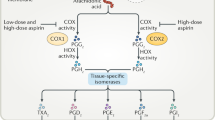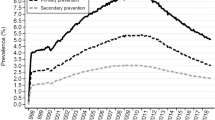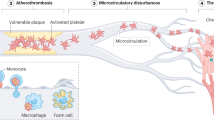Abstract
The term aspirin resistance has been used increasingly in clinical studies. The aim of this Review is to analyze the origin of this term, to discuss the biochemical, functional and clinical correlates of the phenomenon and to offer a conceptual framework to redefine the major determinants of variability between individuals in response to aspirin. Awareness needs to be increased of factors that might interfere with the desired antiplatelet effect of aspirin, particularly in terms of patients' adherence to treatment and avoidable drug interactions with some traditional NSAIDs. Gaining such knowledge could result in improved care of patients and might avoid the requesting of unnecessary platelet function tests of unproven clinical significance.
Key Points
-
Drug resistance generally implies a change of the drug target and can be detected by a specific laboratory test, the results of which have a direct impact on whether drug therapy should be changed
-
Aspirin resistance seems, by contrast, to be indicated by incomplete inhibition of platelet function fluctuating over time and to be partly reversible with increasing aspirin dose
-
Testing for aspirin resistance and changing therapy on the basis of laboratory tests is currently not recommended because of a lack of data on the efficacy and safety of this strategy
-
Variability between individuals in response to low-dose aspirin is determined partly by pharmacodynamic interactions with some traditional NSAIDs and aspirin-insensitive sources of thromboxane biosynthesis
-
Increased awareness of the factors potentially limiting the antiplatelet effect of aspirin, particularly patients' adherence to therapy and drug interactions, could improve the clinical efficacy and safety of low-dose aspirin
This is a preview of subscription content, access via your institution
Access options
Subscribe to this journal
Receive 12 print issues and online access
$209.00 per year
only $17.42 per issue
Buy this article
- Purchase on Springer Link
- Instant access to full article PDF
Prices may be subject to local taxes which are calculated during checkout




Similar content being viewed by others
References
Patrono C et al. (2005) Low-dose aspirin for the prevention of atherothrombosis. N Engl J Med 353: 2373–2383
Born G and Patrono C (2006) Antiplatelet drugs. Brit J Pharmacol 147 (Suppl 1): S241–S251
Patrignani P et al. (1982) Selective cumulative inhibition of platelet thromboxane production by low-dose aspirin in healthy subjects. J Clin Invest 69: 1366–1372
FitzGerald GA et al. (1983) Endogenous biosynthesis of prostacyclin and thromboxane and platelet function during chronic administration of aspirin in man. J Clin Invest 71: 678–688
Helgason CM et al. (1993) Aspirin response and failure in cerebral infarction. Stroke 24: 1259–1261
Helgason CM et al. (1994) Development of aspirin resistance in persons with previous ischemic stroke. Stroke 25: 2331–2336
Hankey GJ and Eikelboom JW (2006) Aspirin resistance. Lancet 367: 606–617
Patrono C (2003) Aspirin resistance: definition, mechanisms and clinical read-outs. J Thromb Haemost 1: 1710–1713
Glossary of Department of Health and Human Services Center for Disease Control and Prevention [http://www.cdc.gov/drugresistance/glossary.htm]
Rocca B et al. (2002) Cyclooxygenase-2 expression is induced during human megakaryopoiesis and characterizes newly formed platelets. Proc Natl Acad Sci USA 99: 7634–7639
Halushka MK et al. (2003) Genetic variation in cyclooxygenase 1: effects on response to aspirin. Clin Pharmacol Ther 73: 122–130
Maree AO et al. (2005) Cyclooxygenase-1 haplotype modulates platelet response to aspirin. J Thromb Haemost 3: 2340–2345
Wang TH et al. (2006) Aspirin and clopidogrel resistance: an emerging clinical entity. Eur Heart J 27: 647–654
Patrono C et al. (2004) Platelet-active drugs: the relationships among dose, effectiveness, and side effects: the Seventh ACCP Conference on Antithrombotic and Thrombolytic Therapy. Chest 126 (Suppl 3): S234–S264
FitzGerald GA et al. (1983) Analysis of prostacyclin and thromboxane biosynthesis in cardiovascular disease. Circulation 67: 1174–1177
Patrono C et al. (1980) Low-dose aspirin and inhibition of thromboxane B2 production in healthy subjects. Thromb Res 17: 317–327
Patrono C et al. (1986) Estimated rate of thromboxane secretion into the circulation of normal humans. J Clin Invest 77: 590–594
Reilly IA and FitzGerald GA (1987) Inhibition of thromboxane formation in vivo and ex vivo: implications for therapy with platelet inhibitory drugs. Blood 69: 180–186
Yu Y et al. (2005) Differential impact of prostaglandin H synthase 1 knock-down on platelets and parturition. J Clin Invest 115: 986–995
Fontana P et al. (2005) Aspirin and clopidogrel resistance: a study on 96 healthy volunteers and role of the P2Y12 H1/H2 gene polymorphism [abstract # P0356]. J Thromb Haemost 3 (Suppl 1)
Maree AO et al. (2005) Platelet response to low-dose enteric-coated aspirin in patients with stable cardiovascular disease. J Am Coll Cardiol 46: 1258–1263
Capone ML et al. (2004) Clinical pharmacology of platelet, monocyte, and vascular cyclooxygenase inhibition by naproxen and low-dose aspirin in healthy subjects. Circulation 109: 1468–1471
Capone ML et al. (2005) Pharmacodynamic interaction of naproxen with low-dose aspirin in healthy subjects. J Am Coll Cardiol 45: 1295–1301
Tantry US et al. (2005) Overestimation of platelet aspirin resistance detection by thrombelastograph platelet mapping and validation by conventional aggregometry using arachidonic acid stimulation. J Am Coll Cardiol 46: 1705–1709
Cipollone F et al. (2004) Cyclooxygenase-2 expression and inhibition in atherothrombosis. Arterioscler Thromb Vasc Biol 24: 246–255
Evangelista V et al. (2006) De novo synthesis of cyclooxygenase-1 counteracts the suppression of platelet thromboxane biosynthesis by aspirin. Circ Res 98: 593–595
Vejar M et al. (1990) Dissociation of platelet activation and spontaneous myocardial ischemia in unstable angina. Thromb Haemost 63: 163–168
Cipollone F et al. (1997) Differential suppression of thromboxane biosynthesis by indobufen and aspirin in unstable angina. Circulation 96: 1109–1116
Cipollone F et al. (2000) Oxidant stress and aspirin-insensitive thromboxane biosynthesis in severe unstable angina. Circulation 102: 1007–1013
Van Kooten F et al. (1999) Increased thromboxane biosynthesis is associated with post-stroke dementia. Stroke 30: 1542–1547
Eikelboom JW et al. (2002) Aspirin-resistant thromboxane biosynthesis and the risk of myocardial infarction, stroke, or cardiovascular death in patients at high risk for cardiovascular events. Circulation 105: 1650–1655
Hennekens CH et al. (2004) Terms and conditions: semantic complexity and aspirin resistance. Circulation 110: 1706–1708
Harrison P et al. (2005) Screening for aspirin responsiveness after transient ischemic attack and stroke: comparison of 2 point-of-care platelet function tests with optical aggregometry. Stroke 36: 1001–1005
Cattaneo M (2004) Aspirin and clopidogrel: efficacy, safety, and the issue of drug resistance. Arterioscler Thromb Vasc Biol 24: 1980–1987
Patrono C et al. (2004) Expert consensus document on the use of antiplatelet agents. The Task Force on the Use of Antiplatelet Agents in Patients with Atherosclerotic Cardiovascular Disease of the European Society of Cardiology. Eur Heart J 25: 166–181
Michelson AD et al. (2005) Aspirin resistance: position paper of the Working Group on Aspirin Resistance. J Thromb Haemost 3: 1309–1311
Pedersen AK and FitzGerald GA (1984) Dose-related kinetics of aspirin: presystemic acetylation of platelet cyclooxygenase. N Engl J Med 311: 1206–1211
Loll PJ et al. (1995) The structural basis of aspirin activity inferred from the crystal structure of inactivated prostaglandin H2 synthase. Nat Struct Biol 2: 637–643
Catella-Lawson F et al. (2001) Cyclooxygenase inhibitors and the antiplatelet effects of aspirin. N Engl J Med 345: 1809–1817
Corman SL et al. (2005) Impact of nonsteroidal antiinflammatory drugs on the cardioprotective effects of aspirin. Ann Pharmacother 39: 1073–1079
García Rodríguez LA et al. (2004) Nonsteroidal antiinflammatory drugs and the risk of myocardial infarction in the general population. Circulation 109: 3000–3006
Roth GJ et al. (1975) Acetylation of prostaglandin synthase by aspirin. Proc Natl Acad Sci USA 72: 3073–3076
ISIS-2 (Second International Study of Infarct Survival) Collaborative Group (1988) Randomised trial of intravenous streptokinase, oral aspirin, both, or neither among 17,187 cases of suspected acute myocardial infarction: ISIS-2. Lancet 2: 349–360
Landolfi R et al. (2004) Efficacy and safety of low-dose aspirin in polycythemia vera. N Engl J Med 350: 114–124
Gum PA et al. (2003) A prospective, blinded determination of the natural history of aspirin resistance among stable patients with cardiovascular disease. J Am Coll Cardiol 41: 961–965
Matetzky S et al. (2004) Clopidogrel resistance is associated with increased risk of recurrent atherothrombotic events in patiens with acute myocardial infarction. Circulation 109: 3171–3175
Acknowledgements
The authors are supported by grants from the Italian Ministry of University and Research (FIRB Project RBNE 01A882) and the European Union (EICOSANOX Project LSHM-CT-2004-005033) to the Center of Excellence on Aging of the “G. d'Annunzio” University Foundation. The expert editorial assistance of Laura Di Benedetto and Daniela Basilico is gratefully acknowledged.
Author information
Authors and Affiliations
Corresponding author
Ethics declarations
Competing interests
Carlo Patrono received lecture and consulting fees for AstraZeneca, Bayer AG, Eli Lilly, Nicox, sanofi-aventis and Servier. Bianca Rocca has received lecture fees from Nycomed.
Rights and permissions
About this article
Cite this article
Patrono, C., Rocca, B. Drug Insight: aspirin resistance—fact or fashion?. Nat Rev Cardiol 4, 42–50 (2007). https://doi.org/10.1038/ncpcardio0728
Received:
Accepted:
Issue Date:
DOI: https://doi.org/10.1038/ncpcardio0728
This article is cited by
-
Platelets, diabetes and myocardial ischemia/reperfusion injury
Cardiovascular Diabetology (2017)
-
Time-dependent changes in non-COX-1-dependent platelet function with daily aspirin therapy
Journal of Thrombosis and Thrombolysis (2012)
-
Non-compliance is the predominant cause of aspirin resistance in chronic coronary arterial disease patients
Journal of Translational Medicine (2008)
-
Drug Insight: aspirin resistance—fact or fashion?
Nature Clinical Practice Cardiovascular Medicine (2007)
-
Authors’ response to “Drug Insight: aspirin resistance—fact or fashion?”
Nature Clinical Practice Cardiovascular Medicine (2007)



